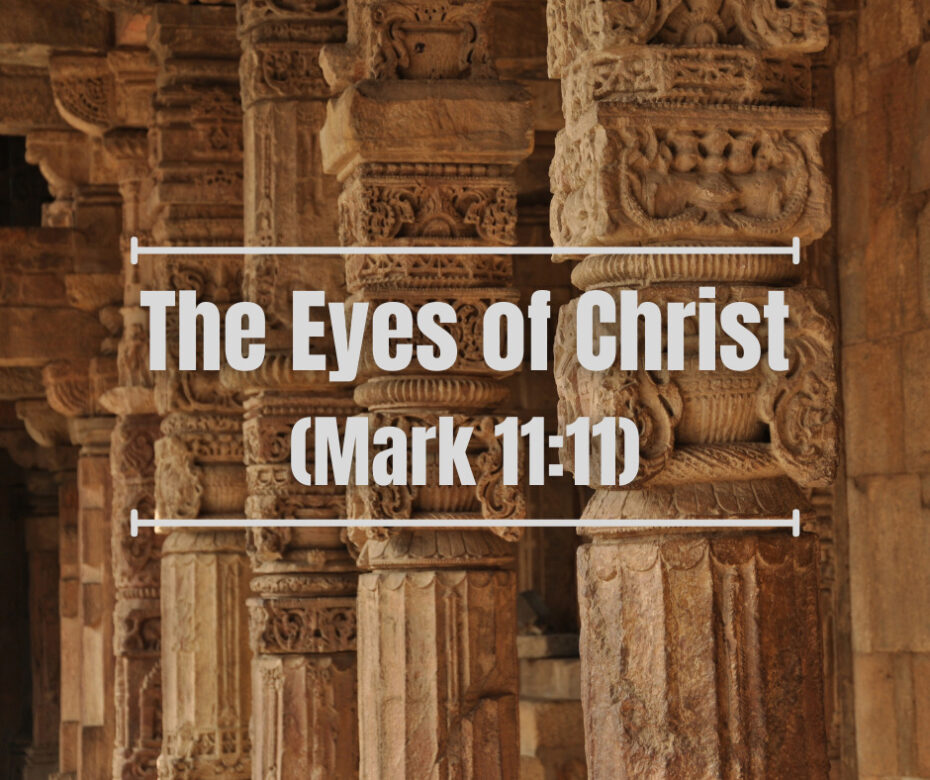All of us have found ourselves in a situation where we are with somebody, and we realize that the other person sees things differently than we do. They notice things we do not. There are many examples of this. For example, I know nothing about cars. I can look at a newly pressured-washed engine and think, “Now that is a really nice looking engine; looks perfect to me. I bet this car runs extremely well.” An experienced mechanic can look at the same engine and see that it is missing a carburetor and won’t even start. In his eyes, the engine is useless.
One of the things that any Christian who wants to grow spiritually realizes is that the Lord sees things differently than we do in many ways. We may look at a situation and think all is well. But when we study the Scriptures, the Spirit reveals to us that the Lord does not see it the same way. It is correct to say that spiritual growth is the process by which we begin to see things as the Lord sees them. We should pray that we would have the eyes of Christ.
There are many ways the Bible teaches us this truth. One of the clearest places is found in Mark 11–13. These chapters go together and form a unit. They speak of the fact that the nation of Israel will reject Jesus as the Christ. As a result, judgment will fall on the nation. It is not surprising, then, that the temple in Jerusalem plays a major role in these chapters. The temple was the pride of the Jews. Visitors from all over the world would come to Jerusalem to see it and to worship God there. If the nation was to be judged, the temple would be at the center of that judgment.
When chap. 11 begins, Jesus rides from the Mount of Olives into Jerusalem. He could see the temple in all its glory as He approached the city. When He arrives, He immediately goes to the temple (11:11). Almost all of chap. 11 deals with Jesus either in the temple or talking about it. All of chap. 12 finds Him in it, teaching there. In chap. 13, He gives His longest section of teaching in the Book of Mark—the Olivet Discourse. He begins this “sermon” by talking about the temple (13:1-2).
The temple, then, plays a major role in Mark 11–13. When the Lord looked at it, how did He see it? Before we consider that question, it might be helpful to see how the disciples saw it.
No doubt, when the disciples were with the Lord when He rode into Jerusalem from the Mount of Olives, they thought the temple was perfect. Ancient descriptions of it say that the sun would shine off the gold that was part of the buildings. The stones were huge and made of marble. It was a massive complex of buildings, and the vast majority of the citizens of Israel thought it was the most beautiful place on earth. In addition, it was the temple of the only true God, the God of Israel. It was the most holy place on earth.
We know that this is how the disciples saw the temple with their own eyes. In 13:1, they are with the Lord back on the Mount of Olives. Once again, they can see the temple across the valley. They say to Him, “Look at the temple Lord. Look how wonderful it is!”
But how did the Lord see the temple? What did His eyes see?
We are not left in doubt. We read that He did not see things the way the disciples did. In this section of Mark, when the Lord first comes to the temple, we are told that He “looked” around (Mark 11:11). It was late in the day, so He had to leave the city with His disciples. But He did not forget what He had seen. He returned the next day and created havoc in the temple. He did not see it as a beautiful place of worship. He saw it as a place where thieves would congregate. He ran them out of the place, turning over the tools by which they robbed the people.
In this section of Mark, on a different day when Jesus leaves the temple for the last time, He “looks” around once again (12:41). This time, He sees a poor widow. She is a victim of the thieves in that place. She also contrasts the hypocrisy that the Lord observes going on around her in the temple (12:43-44).
It is no wonder, then, that in the very next verse (13:1) when the disciples tell Jesus to “look” at the temple and comment how beautiful it is, He tells them He doesn’t “see” it the same way (13:2). He tells them God is going to judge it. In very simple terms, when the disciples tell Jesus to “look” at the temple, He tells them that He already has. He didn’t like what He saw. He could look past the gold and the marble and knew what it was really like.
The disciples were like I am when I see a clean engine missing a carburetor. The temple looked great to them. The gold and marble fooled them. But the Lord was like a perfect mechanic with perfect knowledge of an engine. He knew the temple was an abomination to His Father. What a difference it makes to see things through the eyes of the Lord.
As believers, we should always be seeking to understand how the Lord sees the things that we do and how we think. Where have we been fooled by the standards of the world and see things around us with our own eyes? May our constant prayer be that the Lord would, through His Spirit who lives within us, allow us to see things through His eyes.


